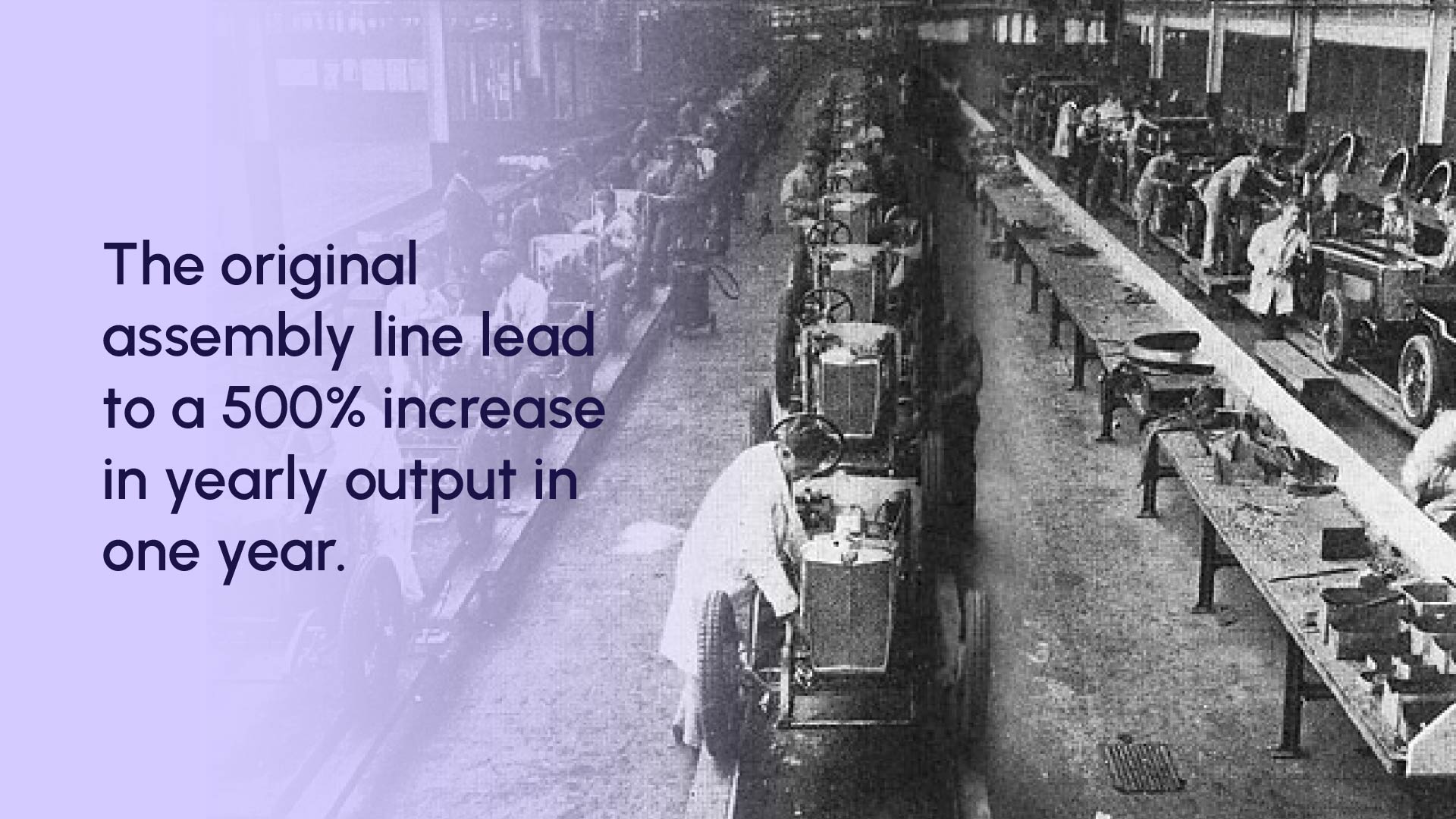Optimizing Sales and Operations: How to Unlock the Power of Digital Assembly Lines
Optimizing Sales and Operations: How to Unlock the Power of Digital Assembly Lines
Jul 18, 2024


In the early 20th century, Henry Ford revolutionized the automotive industry with the introduction of the assembly line for Model T cars. This innovative approach drastically reduced production time and costs, making cars more affordable and accessible to the masses.
By incorporating the assembly line, the manufacturing process is organized and predictable. This method establishes a set timeline, the tools and materials needed, and defines each employees role in the process. It's a tangible solution that works almost every time.

Drawing inspiration from Ford's pioneering method, the same principles can be applied to build software that delivers transparency and efficiency for its users.
By streamlining processes and leveraging digital tools, the Digital Assembly Line provides the same level of transformative value and productivity that the physical assembly line brought to manufacturing.
After working with thousands of organizations, we have discovered that a startling majority of businesses are operating via outdated, unorganized, dysfunctional processes with little-to-no data backing up big business decisions.
The need for streamlined business processes is real. According to a study from Harvard University, "75% of cross-functional teams are dysfunctional", and a recent Forbes article also stated that "internal process improvement is the second most overlooked area of business efficiency."
With that being said, here’s a detailed look at how a Digital Assembly Line can really benefit Sales and Operations Teams:
For Sales Teams:
✅ Increased Productivity and Efficiency:
Automated Processes: Automating repetitive tasks such as data entry, lead follow-up, and reporting frees up sales representatives to focus on more strategic activities like building relationships and closing deals.
Streamlined Workflows: Integrated digital tools ensure a seamless workflow from lead generation to closing, reducing the time spent on administrative tasks.
✅ Enhanced Data Management:
Centralized Information: A digital assembly line integrates CRM systems, providing a single source of truth for all customer data. This enhances data accuracy and accessibility.
Real-Time Analytics: Sales teams can access real-time analytics and insights, enabling them to make informed decisions quickly and adjust strategies as needed.
✅ Improved Customer Experience:
Personalized Interactions: Automation and data integration allow for more personalized communication with prospects and customers, improving engagement and satisfaction.
Consistent Follow-Up: Automated reminders and follow-ups ensure that no lead or opportunity falls through the cracks, enhancing the customer journey.
✅ Scalability:
Easily Adaptable: As the business grows, digital tools can easily scale, allowing sales processes to expand without significant additional overhead.
Flexible Tools: Digital platforms can be customized and adapted to meet the changing needs of the sales team, supporting diverse sales strategies.
For Operations Teams:
✅ Efficiency and Automation:
Automated Workflow Management: Routine tasks such as order processing, inventory management, and logistics can be automated, reducing manual effort and errors.
Process Standardization: A digital assembly line standardizes processes across the operations team, ensuring consistency and reliability.
✅ Enhanced Collaboration:
Integrated Platforms: Digital tools integrate various aspects of operations, from supply chain management to production planning, facilitating seamless collaboration across departments.
Real-Time Communication: Enhanced communication tools ensure that all team members are on the same page, reducing miscommunication and improving coordination.
✅ Data-Driven Decision Making:
Comprehensive Analytics: Operations teams have access to detailed analytics and KPIs, enabling them to monitor performance, identify inefficiencies, and make data-driven improvements.
Predictive Insights: Advanced analytics provide predictive insights, helping operations teams anticipate issues and proactively manage resources.
✅ Scalability and Flexibility:
Adaptable Systems: Digital tools can be scaled up or down based on demand, making it easier to manage peak periods without compromising efficiency.
Customizable Workflows: Operations teams can customize digital workflows to meet specific business needs, ensuring optimal performance.
Additional Value Across BOTH Teams:
🤝 Improved Integration and Coordination:
Unified Systems: Digital assembly lines integrate sales and operations systems, ensuring seamless handoffs and collaboration between teams. This reduces friction and enhances overall performance.
Aligned Goals: With integrated data and workflows, sales and operations teams can better align their goals and strategies, working towards common objectives.
💸 Cost Reduction:
Operational Efficiency: Automation reduces the need for manual labor, decreasing operational costs and freeing up resources for strategic initiatives.
Resource Optimization: Efficient resource management through digital tools ensures that both sales and operations teams can optimize their use of time, materials, and budget.
🔒 Enhanced Compliance and Security:
Regulatory Compliance: Automated processes ensure that compliance with industry regulations is consistently maintained, reducing the risk of non-compliance penalties.
Data Security: Digital tools often come with robust security measures, protecting sensitive customer and operational data from breaches and ensuring business continuity.
Providing Continuous Improvement:
📚 Continuous Learning and Adaptation:
Feedback Loops: Digital systems facilitate continuous feedback and learning, enabling teams to iterate and improve processes based on real-time performance data.
Innovation Enablement: With routine tasks automated, teams have more capacity to focus on innovative projects and strategic improvements.
📊 Market Competitiveness:
Agility: The ability to quickly adapt to market changes and customer demands gives companies a competitive edge, ensuring they remain relevant and responsive in a fast-paced business environment.
Implementing the Digital Assembly Line to YOUR Business:
In essence, a Digital Assembly Line can completely transform your Sales and Operations Teams by enhancing productivity, improving data management, facilitating collaboration, enabling scalable growth, and so much more. It's an effective solution that has helped develop more efficient, responsive, and competitive organizations for more than a century.
Applying the Digital Assembly Line to your business is much easier than you might think, especially when you partner with Vsimple.

Our team of Workflow Solution Specialists does all of the work for you, from analyzation of your sales and operations processes to optimization to software build-out. We've got your back!
Curious how it works? Schedule a quick chat with our team today to learn more.
Get Started with Vsimple
© 2025 Vsimple Inc
Get Started with Vsimple
© 2025 Vsimple Inc
Get Started with Vsimple
© 2025 Vsimple Inc


